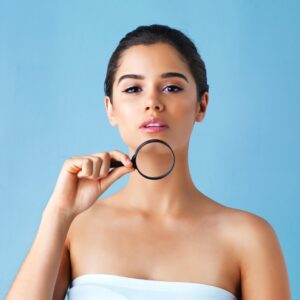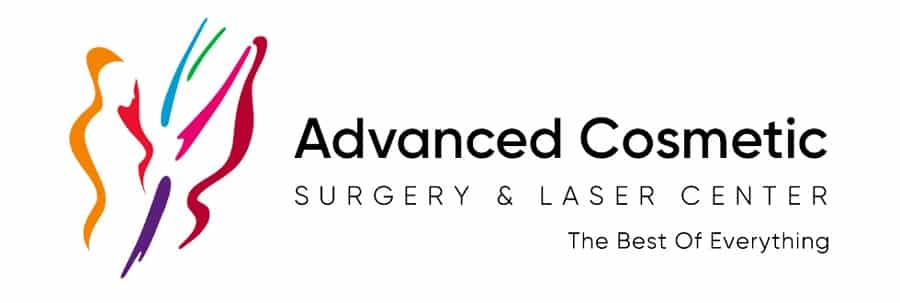While a double chin isn’t a big deal from a health perspective, it can be frustrating to deal with—especially because it’s not the easiest feature to get rid of. According to experts, everything from genetics to jaw structure can play a role in a little extra fat accumulating under your chin. But if you naturally have a double chin, are you destined to have one forever? Here’s what the experts say if you’re wondering how to get rid of a double chin.
What causes a double chin?
A double chin can be associated with weight gain or excessive weight, but some individuals simply have more fat cells in this area than others. And hey, that’s OK. We all know, all bodies are beautiful at every size—regardless of where they tend to carry fat. “Genetics play a role here in the same way some people can have larger thighs or carry weight in their abdomen,” explains Karen Whitney, a physician’s assistant with Advanced Cosmetic Surgery & Laser Center in Cincinnati, Ohio, noting that “mild versions of a double chin can be seen in young people of appropriate weight and become more pronounced with increased weight and skin laxity associated with aging.”
It’s important to work on loving your body at any size, double chin or not. But if it’s irking you, here are some ideas for eliminating it.
How to get rid of a double chin
Set a workout goal
According to Dr. Gary Motykie, a board-certified plastic surgeon in Beverly Hills, California, anything that decreases overall body weight and improves neck skin tone will help you get rid of a double chin naturally. “Consider creating a caloric deficit by lowering calorie intake and increasing caloric expenditure through workouts,” says personal trainer Kate Horney of Beyond Fit Mom. “My recommended workout routine would be to focus on short duration, high intensity sprint workouts and ‘metcon,’ or metabolic conditioning workouts, that help your body burn fat not just during the workout but after the workout is over,” she suggests.
Related: Whole30 vs Keto Face-Off: Which Low-Carb Diet Is Better for Losing Weight?
Eat healthy
While eliminating a double chin shouldn’t be your primary reason for eating a balanced diet—it will improve your mental health and give you more energy, too—Dr. Sapna Palep of Spring Street Dermatology in New York City says opting for healthy foods can help with excess facial fat. “Eat low fat, low sodium, fruits and vegetables, drink a lot of water,” she says, noting that “a diet high in calories, processed foods, and unhealthy fats may influence weight gain and a double chin as well.” She adds that proper hydration allows for more easily processed waste and better lymphatic drainage, which helps reduce the look of a double chin.
Try some at-home neck exercises
Experts like Whitney say that these home remedies for double chin are more anecdotal than effective, but others maintain that there’s no harm in trying.
“I’ve seen some at-home neck exercises that include putting a stress ball between the chin and chest and squeezing the stress ball. While this will strengthen your neck muscles, it won’t get rid of fat or excess skin which could be the cause of the double chin,” says Jonathan Kaplan MD, MPH, a board certified plastic surgeon with Pacific Heights Plastic Surgery.
Rina Allawh, MD, a board-certified dermatologist practicing in the Philadelphia area, suggests doing the following exercises regularly for double chin prevention and treatment:
- Stick out your tongue, stretch it up and out for 10-15 second intervals.
- Chin presses with the aid of a resistance ball (this strengthens jaw muscles)
- Neck rotations and projecting or jutting the lower jaw forward and holding it for 10 seconds (this strengthens neck muscles)
Related: Is the Bosu Ball the Answer to Our Fitness Dreams? We Think So, Yes!
Cynthia Rowland, the creator of facial exercise system Face Magic, says the following six exercises may help strengthen and tone the muscles and skin in the area of your double chin. Repeat these exercises 10 to 15 times on a daily basis.
- Straight jaw jut: Tilt your head back and look toward the ceiling. Push your lower jaw forward to feel a stretch under the chin. Hold the jaw jut for a 10 count. Relax your jaw and return your head to a neutral position.
- Ball exercise: Place a nine or 10-inch ball under your chin. Press your chin down against the ball. Repeat 25 times.
- Pucker up: With your head tilted back, look at the ceiling. Pucker your lips as if you’re kissing the ceiling to stretch the area beneath your chin. Stop puckering and bring your head back to its normal position.
- Tongue stretch: Looking straight ahead, stick your tongue out as far as you can. Lift your tongue upward and toward your nose. Hold for 10 seconds and release.
- Neck stretch: Tilt your head back and look at the ceiling. Press your tongue against the roof of your mouth. Hold for five to 10 seconds and release.
- Bottom jaw jut: Tilt your head back and look at the ceiling. Turn your head to the right. Slide the bottom part of your jaw forward. Hold for five to 10 seconds and release. Repeat the process with your head turned to the left.
Cosmetic procedures
According to Erin Jensen, CEO/PA-C of The Treatment Skin Boutique, in recent years, many non-surgical advances have been made in the way of helping people get rid of stubborn pockets of fat without going under the knife. The following treatments have been recognized as successful ways to help to reduce the appearance of a double chin:
- Fillers and botox: These nonsurgical methods can be used to define the appearance of the jawline. Though they don’t remove the fat in the submental area, they may help reduce the appearance and prominence of the double chin by defining the architecture of the jawline.
- Kybella: Kybella is made of deoxycholic acid, a naturally occurring enzyme in the stomach, that breaks down fat in the foods we eat. “We can now inject this enzyme into targeted pockets of fat (like a double chin) to break down fat for your body to slowly absorb over the next four to eight weeks,” Jensen says, adding that after two to four weeks, patients can expect to see a slimmer, more svelte chin.
- Trusculpt: This process uses radio frequency to melt the fat under chin. According to Palep, two to three treatments about four weeks apart will yield optimal results.
- BTL Exilis: This treatment combines radio frequency and ultrasound to not only reduce fat (adipose) tissue on the face and body, but tighten the skin. “This is especially helpful for those with sagging skin in the chin area,” says Allawh. Typically two to four treatments are recommended, performed one week apart.
- Non-surgical skin tightening: This can be performed with technologies like Zaffiro (which uses infrared energy to heat the tissues, producing a tightening effect), Ultherapy (ultrasound), and Profound (radiofrequency microneedling), says Dr. Steven A. Goldman, MD, a plastic surgeon and expert at Derm Collective.
- Cryosculpting: Cryosculpting is a non-invasive treatment that uses both cold temperatures and muscle stimulation to freeze and get rid of fat cells for good, according to Peterson Pierre, a board certified dermatologist in Thousand Oaks, California.
- Ice 21’s Cryotone: This machine firms and tones your muscles while draining out the lymphatic areas of your body, improving circulation and the texture of your skin, according to Pierre. He adds that it can be used on your abdomen, thighs, and buttocks as well as on a double chin. This is “a quick-and-easy, painless, and relatively affordable solution to getting rid of a double chin once and for all.”
- CoolSculpting: CoolSculpting uses cold temperatures to freeze fat cells. This, says Pierre, “is the single best non-invasive fat treatment that we have.” A series of treatments delivers the best results without the swelling or bruising associated with other treatments, such as Kybella.
- Liposuction: The gold standard in double chin reduction, says Rian A. Maerks, M.D., medical director at The Marecks Institute in Miami, is liposuction. “The transformations can be dramatic.” And these day, submental liposuction is not a heavy surgery, according to Pierre. He explains that this can be done under local anesthesia in the office and that you’re awake throughout. “The good thing about this is that it takes an hour or less and the swelling and downtime is not too bad.”



Recent Comments